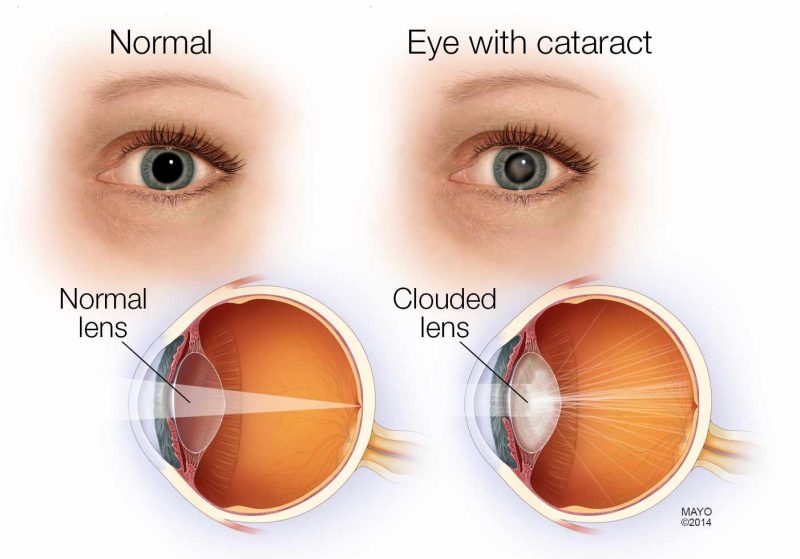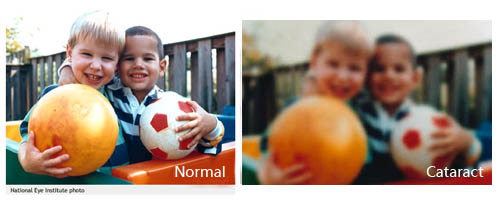As Remembrance Day approaches, may we all remember to be thankful to our veterans who shaped the Canada we have today and to all the individuals who currently serve. As many of our veterans are part of the aging population, it is important to care of the changes that all of our eyes go through as we celebrate our birthdays. Cataracts are something we will all develop given the time and will have to deal with – but it’s not as scary as some might make it out to be.

To understand what cataracts are, we need to first know a little bit of anatomy. Cataracts develop and grow in the lens within our eyes. The lens is what provides the focusing power of our eyes. The muscles that control the focus point of the lens allow us to read things up close (until we reach the ripe age when those muscles stop working – presbyopia). It is the natural clouding of the our lens and it’ll happen to all of us and the best of us – it’s how our bodies age. The same way our hair turns grey, our lens will become cloudy.

During the early stages of cataracts, we probably won’t notice too much. It is only when the clouding becomes dense enough that it impairs our vision. We will start to notice that we “need more light” to see things clearly because the cataracts are blocking the light from entering our eyes. Also, because brunescence (browning of cataracts) occurs, our colour perception is affected as well. Colours will appear more dull and not as vibrant. In addition to visual perception changes, cataracts can also change our prescription depending on the type of cataract forming. Nikon has developed a new lens coating called SeeCoat Bright that helps to relieve these issues with low-light visibility and colour perception. They can make us more near-sighted, far-sighted, or develop more astigmatism. A simple update in prescription can negate these affects during the early stages. Cataracts also scatter light within the eye so it is harder to focus when glare is involved or seeing clearly when driving at night when it’s raining. It is only when the cataracts have matured enough that glasses can no longer correct for those changes that we would require surgery.

Cataract surgery is the only treatment for mature cataracts. It is crucial that individuals with cataracts receive regular eye exams to ensure the timing for the surgery is right. It’s not bad to have it done earlier but it is more dangerous and not as successful to have cataract surgery when a cataract is hyper-mature. The procedure is more complicated and harder for the surgeon to perform when the surgery has grown too dense. What is done is the ophthalmologist will remove the clouded lens and replace it with an implant so that the individual can see clearly again. Most of the time, the surgeon will try to eliminate the distance prescription with the implant so that only reading glasses are required – but it’s not always 100% accurate. There is usually still a bit of a residual prescription but it is up to the patient if they want to have that corrected with glasses or not. With technological advancements, there are actually multifocal lens implants that enable a patient to not require any glasses after the surgery; however, the clarity and functionality of these lenses varies from person to person. Consulting with the ophthalmologist about these alternatives is the best thing if that is an option for you or someone in your family.

Unfortunately there’s nothing we can do to stop cataracts but there are things we can do to prevent them from maturing faster. Ultra-violet rays are a big factor in how fast cataracts grow. It is important to use protective sunwear when we spend time outdoors to protect our eyes. Smoking also increases the risk of developing cataracts at an earlier age – along with many other negative side affects to the eyes. Other systemic diseases such as diabetes can also affect how cataracts form in our eyes. There are other types of cataracts that can be acquired or that we are born with but this is just about the natural type that grow as we age.
If you are experiencing difficulties with low-light visibility or colour perception and are interested in the Nikon SeeCoat Bright coating, we encourage you to come visit our optometrist at Wink in Burnaby to learn more! We would be more than happy to answer any of your questions to help guide your decision making process.

